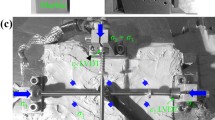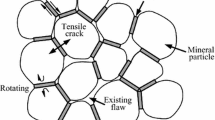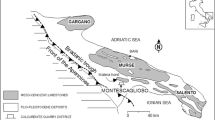Abstract
In high geostress areas, rocks tend to experience plastic deformation processes and show ductility. Therefore, the study of the mechanical properties of rocks, especially the post-peak behavior, is crucial for underground geotechnical engineering. For this reason, the macroscopic mechanical property of marble is studied by using the PFC/PBM numerical method. An improved numerical marble sample with random properties is used by setting different contact strengths following a bimodal Weibull distribution. Thereafter, on the basis of an improved boundary servo mechanism, the brittle–ductile transition appearing in laboratory tests on marble is successfully realized by the discrete approach, and a servo velocity threshold function of axial loading speed and confining pressure is obtained. Furthermore, the marble model and servo method are applied in the excavation of typical underground caverns. The effects of constrained velocity and geostress level on the surrounding rock failure model of the cavern are described and analyzed. In addition, mechanism of the excavation failure under high geostress is discussed.












Similar content being viewed by others
References
Bouchaud JP, Cates ME, Claudin P (1995) Stress distribution in granular media and nonlinear wave equation. J De Phys I 5(6):639–656. https://doi.org/10.1051/jp1:1995157
Burman BC (1980) A discrete numerical-model for granular assemblies. Géotechnique 30(3):331–334
Cao WG, Zhao H, Li X, Zhang YJ (2010) Statistical damage model with strain softening and hardening for rocks under the influence of voids and volume changes. Can Geotech J 47(8):857–871(15). https://doi.org/10.1139/T09-148
Cho N, Martin CD, Sego DC (2007) A clumped particle model for rock. Int J Rock Mech Min Sci 44(7):997–1010. https://doi.org/10.1038/201450d0
Cundall PA, Hart RD (1992) Numerical modelling of discontinua. Eng Comput 9(2):101–113. https://doi.org/10.1108/eb023851
Cundall PA, Potyondy DO (2004) A bonded-particle model for rock. Int J Rock Mech Min Sci 41(8):1329–1364
Cundall PA, Carranza-Torres C, Hart R (2003) A new constitutive model based on the hoek-brown criterion. In: the 3rd international symposium on FLAC and FLAC3D numerical modelling in Geomechanics, pp 17–25
Duan K, Kwok CY, Ma X (2017) Dem simulations of sandstone under true triaxial compressive tests. Acta Geotech 12(3):495–510. https://doi.org/10.1007/s11440-016-0480-6
Hsiao FY, Kao HC (2015) Modeling the post-peak strength degradation on tunnel stability. In: the 3rd international symposium on FLAC and FLAC3D numerical modelling in Geomechanics
Hu K, Zhu QZ, Chen L, Shao JF, Liu J (2018) A micromechanics-based elastoplastic damage model for rocks with a brittle-ductile transition in mechanical response. Rock Mech Rock Eng. https://doi.org/10.1007/s00603-018-1427-z
Inc ICG (2018) PFC2D-particle flow code in 2 dimensions, user’s manual
Johnson NL, Kotz S, Balakrishnan N (1994) Continuous Univariate Distributions. JOHN WILEY and SONS, INC, New Jersey
Lee H, Jeon S (2011) An experimental and numerical study of fracture coalescence in pre-cracked specimens under uniaxial compression. Int J Solids Struct 48(6):979–999. https://doi.org/10.1016/j.ijsolstr.2010.12.001
Li Y, Oh J, Mitra R, Hebblewhite B (2016) A constitutive model for a laboratory rock joint with multi-scale asperity degradation. Comput Geotech 72:143–151. https://doi.org/10.1016/j.compgeo.2015.10.008
Lin Q, Ping C, Wang P (2018) Study of post-peak strain softening mechanical behaviour of rock material based on hoek-brown criterion. Adv Civil Eng. https://doi.org/10.1155/2018/6190376
Liu D, Liu C, Kang Y, Guo B, Jiang Y (2017) Mechanical behavior of benxi formation limestone under triaxial compression: a new post-peak constitutive model and experimental validation. Bull Eng Geol Environ 77:1701–1715. https://doi.org/10.1007/s10064-017-1193-2
Meng F, Zhou H, Zhang C, Xu R, lu J (2014) Evaluation methodology of brittleness of rock based on post-peak stress-strain curves. Rock Mech Rock Eng 48(5):1787–1805. https://doi.org/10.1007/s00603-014-0694-6
Nguyen GD, Nguyen CT, Bui HH, Nguyen VP (2016) Constitutive modelling of compaction localisation in porous sandstones. Int J Rock Mech Min Sci 83:57–72. https://doi.org/10.1016/j.ijrmms.2015.12.018
Paterson MS, Wong T (2005) Experimental Rock Deformation-the Brittle Field. Springer-Verlag, Berlin Heidelberg
Pourhosseini O, Shabanimashcool M (2014) Development of an elasto-plastic constitutive model for intact rocks. Int J Rock Mech Min Sci 66(66):1–12. https://doi.org/10.1016/j.ijrmms.2013.11.010
Shi C, Yang W, Yang J, Chen X (2019) Calibration of micro-scaled mechanical parameters of granite based on a bonded-particle model with 2d particle fow code.pdf. Granul Matter 21(2):21–38. https://doi.org/10.1007/s10035-019-0889-3
Tang C (1997) Numerical simulation of progressive rock failure and associated seismicity. Int J Rock Mech Min Sci 34(2):249–261. https://doi.org/10.1016/S0148-9062(96)00039-3
Tang CA, Liu H, Lee P, Tsui Y, Tham L (2000) Numerical studies of the influence of microstructure on rock failure in uniaxial compression - part I: effect of heterogeneity. Int J Rock Mech Min ences 37(4):555–569. https://doi.org/10.1016/S1365-1609(99)00121-5
Vajdova V, Zhu W, Chen TMN, Wong TF (2010) Micromechanics of brittle faulting and cataclastic flow in tavel limestone. J Struct Geol 32(8):1158–1169. https://doi.org/10.1016/j.jsg.2010.07.007
Wu X, Jiang Y, Guan Z (2018) A modified strain-softening model with multi-post-peak behaviours and its application in circular tunnel. Eng Geol p S0013795216305336, https://doi.org/10.1016/j.enggeo.2018.03.031
Yang SQ, Yin PF, Huang YH, Cheng JL (2019) Strength, deformability and x-ray micro-ct observations of transversely isotropic composite rock under different confining pressures. Eng Fract Mech. https://doi.org/10.1016/j.engfracmech.2019.04.030
Zhang C, Chu W, Liu N, Zhu Y, Hou J (2011) Laboratory tests and numerical simulations of brittle marble and squeezing schist at jinping ii hydropower station, china. J Rock Mech Geotech Eng 3(1):30–38. https://doi.org/10.3724/SP.J.1235.2011.00030
Zhang XP, Wong LNY (2012) Cracking processes in rock-like material containing a single flaw under uniaxial compression: A numerical study based on parallel bonded-particle model approach. Rock Mech Rock Eng 45(5):711–737. https://doi.org/10.1007/s00603-011-0176-z
Zhang XP, Wong LNY (2014) Choosing a proper loading rate for bonded-particle model of intact rock. Int J Fract 189(2):163–179. https://doi.org/10.1007/s10704-014-9968-y
Zhang Y, Liu Z, Shi C, Shao J (2018a) Three-dimensional reconstruction of block shape irregularity and its effects on block impacts using an energy-based approach. Rock Mech Rock Eng 51(4):1173–1191. https://doi.org/10.1007/s00603-017-1385-x
Zhang Y, Shao J, Liu Z, Shi C, De Saxcé G (2018b) Effects of confining pressure and loading path on deformation and strength of cohesive granular materials: a three-dimensional dem analysis. Acta Geotech 14:443–460. https://doi.org/10.1007/s11440-018-0671-4
Zhang YH, Wong LNY (2018) A review of numerical techniques approaching microstructures of crystalline rocks. Comput Geosci 115:167–187. https://doi.org/10.1016/j.cageo.2018.03.012
Zhou CY, Zhu FX (2010) An elasto-plastic damage constitutive model with double yield surfaces for saturated soft rock. Int J Rock Mech Min Sci 47(3):385–395. https://doi.org/10.1016/j.ijrmms.2010.01.002
Acknowledgements
The work presented in this paper was financially supported by the National Natural Science Foundation of China (Grants Nos. 41831278, 51679071), the National Key R&D Program of China (2018YFC1508501) and the Natural Science Foundation of Jiangsu Province (Grant No. BK20171434).
Author information
Authors and Affiliations
Corresponding author
Ethics declarations
Conflict of interest
The authors declare that they have no conflict of interest.
Additional information
Publisher's Note
Springer Nature remains neutral with regard to jurisdictional claims in published maps and institutional affiliations.
Rights and permissions
About this article
Cite this article
Zhang, Y., Shi, C., Zhang, Y. et al. Numerical analysis of the brittle–ductile transition of deeply buried marble using a discrete approach. Comp. Part. Mech. 8, 893–904 (2021). https://doi.org/10.1007/s40571-020-00375-w
Received:
Revised:
Accepted:
Published:
Issue Date:
DOI: https://doi.org/10.1007/s40571-020-00375-w




